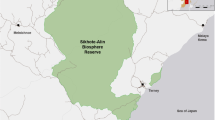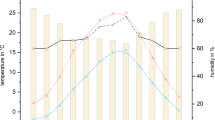Abstract
Reproductive characteristics of tigers (Panthera tigris) are important to understand population viability. We studied the reproductive parameters of female Bengal tigers (P. t. tigris) in a dry, tropical, deciduous habitat in Ranthambhore Tiger Reserve (RTR), western India, from April 2005 to March 2010. We monitored tigers by direct observation and with cameras placed throughout their habitat. The potential breeding population included 13 adult females. The average age at first reproduction was 3.3 years; 34 cubs were born during the study period (6.2 ± 0.82 per year). Sixty-six percent of the births occurred between October and December. Mean litter size was 2.26 ± 0.52 (n = 13, range = 1–3). The sex ratio of 32 cubs was 1.29 M:1.00 F. The survival rate of cubs (<12 months) was 85 % (95 % CI = 0.68–0.94), whereas that of juveniles (12–24 months), and subadults (24–36 months) was 79 % (95 % CI = 0.61–0.91). All breeding females were >3 years old. Only 2 of the 13 females reproduced twice during the 5 years of the study. The birth interval was 33.4 ± 3.7 months (range 24–65 months). The mean reproductive rate was 0.59 ± 0.23 cubs/female/year. Our study indicates that tiger populations can grow rapidly if the habitat provides adequate protection, an adequate population of prey, and minimal to no poaching.




Similar content being viewed by others
References
Balme GA, Batchelor A, Britz NDEW, Seymour G, Grover M, Hes L, Macdonald DW, Hunter LTB (2012) Reproductive success of female leopards Panthera pardus: the importance of top-down processes. Mammal Rev 43:221–237
Berger J, Cunningham C (1995) Multiple bottlenecks, allopatric lineages and bad lands bison Bos bison: consequences of lineages mixing. Biol Conserv 71:13–22
Carter J, Ackleh AS, Leonard BP, Wang H (1999) Giant panda (Ailuropoda melanoleuca) population dynamics and bamboo (subfamily Bambusoideae) life history: a structured population approach to examining carrying capacity when the prey are semelparous. Ecol Model 123:207–223
Champion HG, Seth SK (1968) A revised survey of forest types of India. Government of India, New Delhi
Chapron G, Miquelle DG, Goodrich JM, Legendre S, Clobert J (2008) The impact of poaching versus prey depletion on tigers and other large solitary felids. J Appl Ecol 45:1667–1674
Chauhan DS, Harihar A, Goyal SP, Qureshi Q, Lal PR, Mathur VB (2005) Estimating tiger population using camera traps in Ranthambhore National Park. Final report. Wildlife Institute of India, Dehradun, India
Chundawat RS, Gogate N, Malik PK (2002) Understanding tiger ecology in the tropical dry deciduous forests of Panna Tiger Reserve. Final report. Wildlife Institute of India, Dehradun
Crandall L (1964) The management of wild animals in captivity. University of Chicago Press, Chicago, Illinois
Holt WV, Pickard AR, Rodger JC, Wildt DE (2003) Reproductive science and integrated conservation. Cambridge University Press, Cambridge, UK
Karanth KU (2001) Tigers. Colin Baxter Photography, Scotland
Karanth KU (2003) Tiger ecology and conservation in the Indian subcontinent. J Bombay Nat Hist Soc 100:169–189
Karanth KU, Nichols JD (1998) Estimation of tiger densities in India using photographic captures and recaptures. Ecology 79:2852–2862
Karanth KU, Nichols JD (2002) Monitoring tigers and their prey: a manual for researchers, managers and conservationists in Tropical Asia. Centre for Wildlife Studies, Bangalore, India
Kelly MJ (2001) Lineage loss in Serengeti Cheetahs: consequences of high reproductive variance and heritability of fitness on effective population size. Conserv Biol 15:137–147
Kelly MJ, Laurenson MK, FitzGibbon CD, Collins DA, Durant SM, Frame GW, Bertram BCR, Caro TM (1998) Demography of the Serengeti cheetah (Acinonyx jubatus) population: the first 25 years. J Zool 244:473–488
Kerley LL, Goodrich JM, Miquelle DG, Smirnov NY, Quigley HB, Hornocker MG (2003) Reproductive parameters of wild female Amur (Siberian) tigers (Panthera tigris altaica). J Mammal 84:288–298
Kleiman D (1974) The estrous cycle of the tiger (Panthera tigris). In: Eaton RL (ed) The world’s cats Woodland Park Zoo. Seattle, Washington, pp 60–75
Logan KA, Sweanor LL (2001) Desert puma: evolutionary ecology and conservation of an enduring carnivore. Island Press, Washington
Majumder A, Basu S, Sankar K, Qureshi Q, Jhala YV, Nigam P (2012) Home ranges of the radio-collared Bengal tigers (Panthera tigris tigris L.) in Pench Tiger Reserve, Madhya Pradesh, Central India. Wildl Biol Pract 8:36–49
Mathur VB, Gopal R, Yadav SP, Negi HS (2014) Management Effectiveness Evaluation of tiger reserves. Technical Manual No. WII-NTCA/01/2010 pp 21
Mcdougal C (1991) Chuchchi: The life of a tigress. In: Seidensticker J, Lumpkin S (eds) Great cats. Merehurst, London, United Kingdom, p 104
Nowell K, Jackson P (1996) Wild Cats: Status Survey and Conservation Action Plan IUCN. Gland, Switzerland
Packer C, Herbst L, Pusey AE, Bygott JD, Hanby JP, Cairns SJ, Borgerhoff-Mulder M (1988) Reproductive success in lions. In: Clutton-Brock TH (ed) Reproductive success: studies of individual variations in contrasting breeding systems. University of Chicago Press, Chicago, pp 363–383
Persson J, Landa A, Andersen R, Segerström P (2006) Reproductive characteristics of female wolverines (Gulo gulo) in Scandinavia. J Mammal 87:75–79
Pollock KH, Winterstein SR, Bunck CM, Curtis PD (1989) Survival analysis in telemetry studies: the staggered entry design. J Wildl Manage 53:7–15
Sankar K (1994) The ecology of three large sympatric herbivores (chital, sambar, nilgai) with special reference for reserve management in Sariska Tiger Reserve, Rajasthan PhD thesis. University of Rajasthan, Jaipur
Sankhala KS (1978) Tiger! The story of the Indian tiger Collins. United Kingdom, London
Schaller GB (1967) The deer and the tiger. University of Chicago Press, Chicago
Seal US, Tilson RL, Plotka ED, Reindl NJ, Seal MF (1987) Behavioral indicators and endocrine correlates of estrous and anestrous in Siberian tigers. In: Tilson RL, Seal US (eds) Tigers of the world: the biology, biopolitics, management, and conservation of an endangered species. Noyes Publication, Park Ridge, New Jersey, pp 244–254
Sharma R, Stuckas H, Bhaskar R, Rajput S, Khan I, Goyal SP, Tiedemann R (2008) mtDNA indicates profound population structure in Indian tiger (Panthera tigris tigris). Conserv Genet 10:909–914
Singh R (2011) Assessment of tiger population status and habitat suitability using non-invasive and geospatial tools at landscape level in Ranthambhore National Park PhD thesis. Gurukula Kangri Vishvavidhyala, Haridwar, India
Singh R, Mazumdar A, Sankar K, Qureshi Q, Goyal SP, Nigam P (2013a) Interbirth interval and litter size of free-ranging Bengal tiger (Panthera tigris tigris) in dry tropical deciduous forests of India. Eur J Wildl Res 59:629–636
Singh R, Qureshi Q, Sankar K, Krausman PR, Goyal SP (2013b) Use of camera traps to determine dispersal of tigers in a semi-arid landscape, western India. J Arid Environ 98:105–108
Singh R, Krausman PR, Pandey P, Qureshi Q, Sankar K, Goyal SP, Tripathi A (2014) First parturition of tigers in a semi-arid habitat, western India. Eur J Wildl Res 60:383–386
Smirnov EN, Miquelle DG (1999) Population dynamics of the Amur tiger in Sikhote-Alin State Biosphere Reserve. In: Seidensticker J, Christie S, Jackson P (eds) Riding the tiger: Tiger conservation in human dominated landscapes. Cambridge University Press, Cambridge, UK, pp 61–70
Smith JLD (1993) The role of dispersal in structuring the Chitwan tiger population. Behaviour 124:169–195
Smith JLD, McDougal CW (1991) The contribution of variance in lifetime reproduction to effective population size in tigers. Conserv Biol 5:484–490
Smith JLD, McDougal CW, Sunquist ME (1987) Female land tenure system in tigers. In: Tilson RL, Seal US (eds) Tigers of the world: the biology, biopolitics, management, and conservation of an endangered species. Noyes Publication, Park Ridge, New Jersey, pp 97–109
Sodhi NS, Koh LP, Brook BW, Ng PKL (2004) Southeast Asian biodiversity: an impending disaster. Trends Ecol Evol 19:654–660. doi:10.1016/j.tree.2004.09.006
Sunquist ME (1981) Social organization of tigers (Panthera tigris) in Royal Chitwan National Park, Nepal Smithsonian Contrib Zool
Sunquist ME, Sunquist F (2002) Wild Cats of the World. University of Chicago Press, Chicago
Tamang KM (1982) The status of the tiger (Panthera tigris) and its impact on principal prey populations in the Royal Chitwan National Park, Nepal PhD thesis. Michigan State University, East Lansing
Acknowledgments
We thank the Director and Dean of the Wildlife Institute of India for their support. We thank the Rajasthan Forest Department and the reserve officials and field staff at RTR for permissions and for facilitating this work. We especially thank nature guides of RTR and our field assistants, M. S. Gurjar and S. Sharma, for providing support. The Wildlife Institute of India, Dehra Dun provided financial support for the project. We are also thankful to four anonymous reviewers who have provided their valuable suggestion and comments on an earlier draft.
Author information
Authors and Affiliations
Corresponding author
Additional information
Communicated by C. Gortázar
Rights and permissions
About this article
Cite this article
Singh, R., Qureshi, Q., Sankar, K. et al. Reproductive characteristics of female Bengal tigers, in Ranthambhore Tiger Reserve, India. Eur J Wildl Res 60, 579–587 (2014). https://doi.org/10.1007/s10344-014-0822-3
Received:
Accepted:
Published:
Issue Date:
DOI: https://doi.org/10.1007/s10344-014-0822-3




